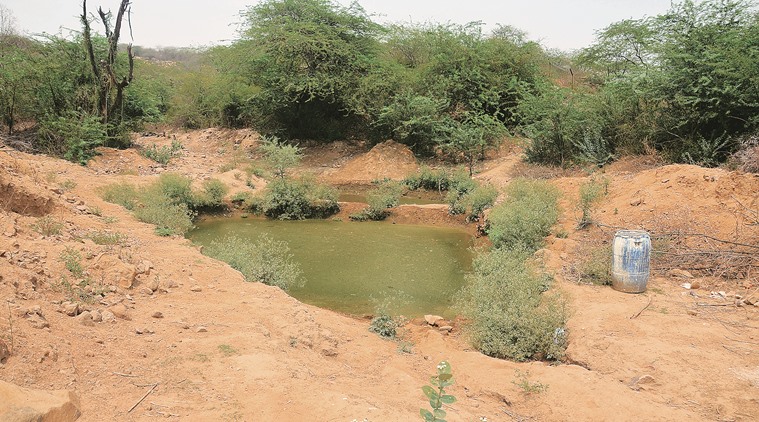 Residents maintain the waterhole (above) for the animals. Manoj Kumar
Residents maintain the waterhole (above) for the animals. Manoj Kumar
On a chilly winter night last December, Fareed Khan, a resident of Gurgaon’s Gairatpur Bas village, was returning home from his field when the headlight from his motorcycle fell on a leopard. It was only a few metres ahead of him, walking down the deserted road, its “tail swinging like a pendulum”.
“I had just entered the lane where my house is located when I saw the leopard. I stopped as it entered the road on its right and disappeared. I waited for a while and then made my way home,” says Khan. Such encounters with predators, villagers say, are a part of their daily lives. Located at the foothills of the Aravallis, Gairatpur Bas is about 10 km from Gurgaon. What sets it apart from other villages in the area, however, is the relationship its residents share with the wildlife of the Aravallis.
While residents of Gairatpur Bas talk of the “mutual respect” they share with these animals, many other villages in the region, which falls in the shadow of the Aravalli hills, have been gripped by man-animal conflicts, which have often resulted in violence and injury to both man and animal. Only 18 months ago, for example, in Mandawar, nearly 40 km from Gairatpur Bas, people beat to death a leopard that had wandered into their village. More recently, in October last year, residents of Dungarpur village armed themselves with sticks and cornered a leopard that had ventured into its lanes. The situation stabilised only after officials arrived and dispersed the crowd. Speaking of the Mandawar incident, Gairatpur Bas residents say, “Someone would have provoked the animal”.
“Leopards tend to come down from the forest on a regular basis, especially early in the morning or after sunset. They are seen in the village at least once in a week or 10 days, even more in the summer when they come down in search of water,” says Rahul, a Gairatpur Bas resident who works for a private company. One such instance when forest department officials had to be summoned was last week, when a leopard was found dead at the edge of a waterhole near a temple on the outskirts of the village. The postmortem report indicated that the animal, estimated to be less than 18 months old, was most likely killed by another feline.
It was Rana Kumar alias Bhola Baba, the priest who resides in the temple premises near the waterhole, who first saw the animal. “The night before, I heard the cries of the animals for several minutes. They seemed to be fighting. But we hear this often so I was not too concerned. Leopards come near the temple very often, but they never bother me,” he says. According to residents, the waterhole, which is spread over two acres and is 10 feet deep, has existed for several decades. They talk of how, “40 or 50 years ago”, an entire community lived in that area.
“When they moved (out), only the temple and the dry waterhole remained. About five or six years ago, we started maintaining it for the animals,” says sarpanch Vinod Kumar, adding, “We fill it up ourselves using tankers… We usually fill it two or three times a month, but in the summers, we sometimes have to do this more often.” Says Divisional Forest Officer (DFO) Shyam Sunder Kaushik, “Residents maintain the waterhole for the animals, we play no role.” Sarpanch Kumar says residents of the village even bathe in the waterhole, undeterred by the presence of wild animals in the area.
“People here are not afraid of them. Before it became illegal to cut trees, our parents and grandparents would go to the forest to collect wood and see leopards sitting on tree branches, unaffected by their presence,” says Nupesh Yadav, a shopkeeper. “There are instances when leopards have preyed on our cattle or livestock, but they will do that. They are predators after all,” says Majeed Khan, a poultry farmer.
Environmentalists attribute this difference in residents’ attitude towards animals to the mining activity in the 1990s and early 2000s. “The belt in which Mandawar (where a leopard was beaten to death) was more affected by mining. As a result, leopards were not seen in the area for almost 15-20 years. So when they re-emerged, it caused panic. Gairatpur Bas was less affected by mining, and so there has been no such gap in the sightings of animals. People know how to deal with them,” says Chetan Agarwal, an environment analyst.
Back in Gairatpur Bas, residents have spent a fortnight animatedly discussing a recent leopard sighting. In the first week of May, word spread throughout the village that a leopard was seen inside one of the temples, taking a nap near the Shiva Linga — a sight villagers describe as a “once in a lifetime experience”. “I was among the people who managed to see it… The leopard had a bulging stomach because it had just eaten a meal, and it was lying on the ground, content and semi-conscious,” says Yadav, the shopkeeper.